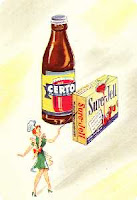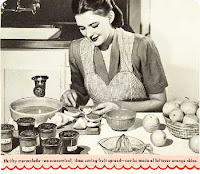What Makes Jelly Jell?
Yes, I have finally returned after an extended absence from this blog. I've been working on another project which I hope to reveal sometime soon. Although I am one who practically lives at the keyboard, I can only stand so much time in front of the computer. It's good to be back.
I still have gazillions of little advertising cookbooks that I wish to share with you here. I never tire of them and hope that you won't either.
 The booklet I chose today, What Makes Jelly "Jell"? (1945, 23 pp.) was produced by the Consumer Service Department of General Foods. This was a 5th printing. This same title was published as late as 1951. The products being promoted within its pages (like you can't guess already) are Certo and Sure-Jell, commerical pectins used in jam and jelly-making.
The booklet I chose today, What Makes Jelly "Jell"? (1945, 23 pp.) was produced by the Consumer Service Department of General Foods. This was a 5th printing. This same title was published as late as 1951. The products being promoted within its pages (like you can't guess already) are Certo and Sure-Jell, commerical pectins used in jam and jelly-making.I love the look of the vintage packaging. Note the lovely old glass Certo bottle that the liquid pectin came in. I think that the never-ending, tireless parade of plastic bottles and pouches used today are boring. I am almost always inspired to buy any product if the manufacturer has taken the trouble to package it in a glass bottle or jar. A utilitarian glass bottle is much more interesting to me than its utilitarian plastic relative.
 Inside the booklet are four Lessons that show you how to make Strawberrry Jam and Grape Jelly, Wintertime Fruit Spreads (Citrus Fruit Marmalade, Thrifty Marmalade, Grape Juice Jelly and Dried Apricot Jam) and also some recipes that use the final results of your efforts. Some of the Jam Cupboard Recipes are for simple things such as Crispy Turnovers and an Old-Fashioned Jelly Roll (Swans Down Cake Flour and Calumet Baking Powder are other General Foods-recommended ingredients here).
Inside the booklet are four Lessons that show you how to make Strawberrry Jam and Grape Jelly, Wintertime Fruit Spreads (Citrus Fruit Marmalade, Thrifty Marmalade, Grape Juice Jelly and Dried Apricot Jam) and also some recipes that use the final results of your efforts. Some of the Jam Cupboard Recipes are for simple things such as Crispy Turnovers and an Old-Fashioned Jelly Roll (Swans Down Cake Flour and Calumet Baking Powder are other General Foods-recommended ingredients here).The jelly-making directions are presented in one of my favorite ways--step-by-step instructions and plenty of visual aids. I believe this was a booklet used in schools, perhaps in a Home Economics class. This is because there are two versions of the recipes--a small size and a large size. The small size, a special two-glass size, was developed for classroom use. The large size recipes make anywhere from 5 to 10 six-ounce glasses. Are there any former Home Ec teachers out there who remember using this particuar pamphlet in the classroom? The format and presentation made it quite useful to students.
One section is devoted to a Water Jelly Demonstration--an easy experiment that shows how the three essentials of fruit, sugar and pectin combine to form a jelly with an ideal set. This would have also been useful in adult homemaking classes or as a demonstration at a state or county fair exhibit. No doubt today's homeschoolers or 4-H members could incorporate it into their lesson plans or projects as well.
 The Lessons are illustrated with those 1940s era pictures that I like so much. The illustrations in the booklet are much like the photographs that can be found in the Cornell University Library Human Ecology Historical Photographs Collection. I like comparing this photo, one of a 1916 rhubarb jelly-making demonstration, to the one at the left which is shown in the booklet.
The Lessons are illustrated with those 1940s era pictures that I like so much. The illustrations in the booklet are much like the photographs that can be found in the Cornell University Library Human Ecology Historical Photographs Collection. I like comparing this photo, one of a 1916 rhubarb jelly-making demonstration, to the one at the left which is shown in the booklet.The clothes worn by the demonstrators in the two photos reflect the almost 30-year difference in fashion--the hairstyles, the aprons, the dresses, but the women shown both appear attentive and so serious about their chore at hand. In this instance, it's almost as if time stood still in the kitchen. The equipment hasn't changed much either; the booklet shows almost the same type jelly bag in another photo, simple glass jars, and a bowl. A reamer is shown in the booklet because she's making a citrus jelly. Chances are that the 1916 photo would show the same glass reamer had they needed it for rhubarb.
 This other photo shows some of the equipment needed for cooking, pouring and covering the jellies. Although now slightly modernized, you would use much the same equipment some sixty years later.
This other photo shows some of the equipment needed for cooking, pouring and covering the jellies. Although now slightly modernized, you would use much the same equipment some sixty years later.This booklet is plumb full of now-collectible kitchen tools and equipment. Some of these things were made so much better in the past than they are now. So much better that I still prefer to use many from this time period in my own cooking today.
Labels: 1940s cookery, Certo, General Foods, jams and jellies, Sure-Jell
